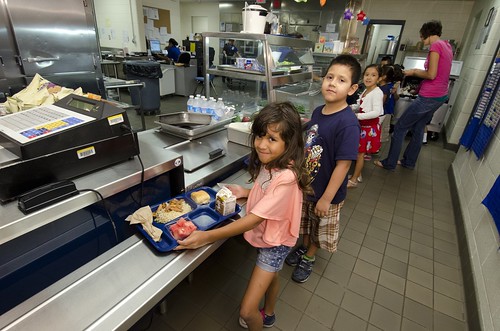
This time of year, it often feels like time is flying by. As we take time to step back and reflect on the past, we often think, “My, my, where did the time go?” or “It feels like just yesterday…” or “How could it be almost 2016 already?” Many of us at USDA are feeling a bit nostalgic too, wondering: “Could it really be half a decade since the Healthy, Hunger-Free Kids Act (HHFKA) passed!?”
But as we commemorate the anniversary of the passage of HHFKA, we realize how far our country has come over the last five years toward achieving the goal of ensuring every American child has access to the nutrition they need to grow into healthy adults. HHFKA’s historic investment in the health of our nation’s children has enabled USDA’s Food and Nutrition Service to expand and improve a number of our programs and services to better help those in need.
One of the biggest changes that came out of HHFKA was the introduction of updated school nutrition standards in school year 2012-2013. Today, over 97 percent of schools report they are meeting the updated standards – which were developed based on expert recommendations from the Institute of Medicine – meaning children nationwide have access to healthy, well-balanced meals. Many schools are integrating fresh, local produce into their menus through farm-to-school initiatives with help from the annual Farm-to-School Grants program established under HHFKA. In addition, USDA Foods revised its requirements based on the latest standards, and now offers more than 200 nutritional foods (such as whole grain pastas and high-protein yogurts) that help support the new meal patterns in schools.
These nutritious meals are especially important to children from low-income households, who may rely on these meals as a consistent source of food. More than 17,500 schools nationwide have implemented HHFKA’s Community Eligibility Provision, offering nutritionally balanced meals at no cost to more than 8 million school children each school day.
HHFKA’s impact also extends beyond schools. The Special Supplemental Nutrition Program for Women, Infants, and Children (WIC), for example, has been able to implement a number of changes, such as increasing breastfeeding promotion efforts and launching a new recognition program - the Loving Support Awards of Excellence - to recognize and celebrate exemplary local WIC breastfeeding programs. In addition, almost all WIC state agencies have implemented, or are in the process of implementing, an electronic benefits transfer (EBT) program, which will be mandatory nationwide under HHFKA starting October 2020. EBT can help reduce participant stigma, speed up the checkout process, and increase program integrity and accuracy.
HHFKA also expanded the mission of the Supplemental Nutrition Assistance Program nutrition education program (SNAP-Ed). While SNAP-Ed continues to be a program for low-income Americans, the HHFKA provision made it easier for states to administer nutrition education, while still allowing funding to grow. Under HHFKA, SNAP-Ed interventions must be evidence-based and outcome driven with a focus on preventing obesity.
While so much has been accomplished over the past five years, the work is not yet over. USDA will continue to work hard, fighting against the hunger and obesity that threatens the future of our country, until all American children have consistent access to healthy food.
As we commemorate this anniversary and take time to consider where we’re seeing success and where we can continue to do more, we must all remember this: If just one more child can rely on receiving consistent meals at school, learns the lifelong value of healthy eating, no longer worries about scrounging up lunch money, or avoids disease by maintaining a balanced diet, that is a victory worth celebrating.
